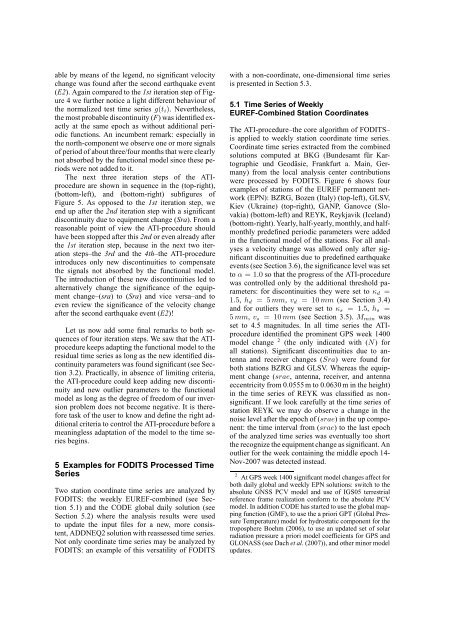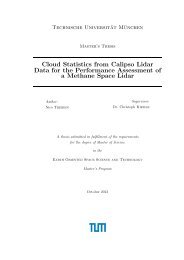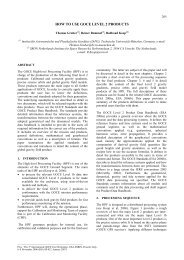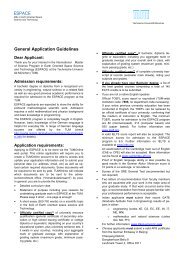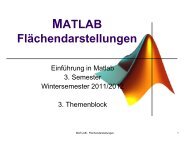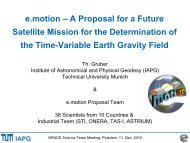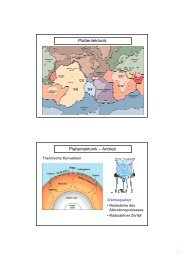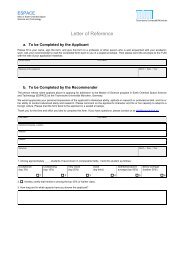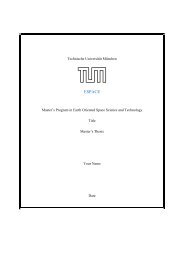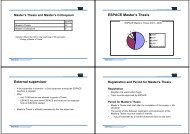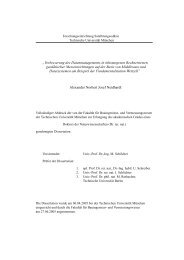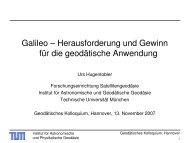FODITS - Institut für Astronomische und Physikalische Geodäsie ...
FODITS - Institut für Astronomische und Physikalische Geodäsie ...
FODITS - Institut für Astronomische und Physikalische Geodäsie ...
You also want an ePaper? Increase the reach of your titles
YUMPU automatically turns print PDFs into web optimized ePapers that Google loves.
able by means of the legend, no significant velocity<br />
change was fo<strong>und</strong> after the second earthquake event<br />
(E2). Again compared to the 1st iteration step of Figure<br />
4 we further notice a light different behaviour of<br />
the normalized test time series g(ti). Nevertheless,<br />
the most probable discontinuity (F) was identified exactly<br />
at the same epoch as without additional periodic<br />
functions. An incumbent remark: especially in<br />
the north-component we observe one or more signals<br />
of period of about three/four months that were clearly<br />
not absorbed by the functional model since these periods<br />
were not added to it.<br />
The next three iteration steps of the ATIprocedure<br />
are shown in sequence in the (top-right),<br />
(bottom-left), and (bottom-right) subfigures of<br />
Figure 5. As opposed to the 1st iteration step, we<br />
end up after the 2nd iteration step with a significant<br />
discontinuity due to equipment change (Sra). From a<br />
reasonable point of view the ATI-procedure should<br />
have been stopped after this 2nd or even already after<br />
the 1st iteration step, because in the next two iteration<br />
steps–the 3rd and the 4th–the ATI-procedure<br />
introduces only new discontinuities to compensate<br />
the signals not absorbed by the functional model.<br />
The introduction of these new discontinuities led to<br />
alternatively change the significance of the equipment<br />
change–(sra) to (Sra) and vice versa–and to<br />
even review the significance of the velocity change<br />
after the second earthquake event (E2)!<br />
Let us now add some final remarks to both sequences<br />
of four iteration steps. We saw that the ATIprocedure<br />
keeps adapting the functional model to the<br />
residual time series as long as the new identified discontinuity<br />
parameters was fo<strong>und</strong> significant (see Section<br />
3.2). Practically, in absence of limiting criteria,<br />
the ATI-procedure could keep adding new discontinuity<br />
and new outlier parameters to the functional<br />
model as long as the degree of freedom of our inversion<br />
problem does not become negative. It is therefore<br />
task of the user to know and define the right additional<br />
criteria to control the ATI-procedure before a<br />
meaningless adaptation of the model to the time series<br />
begins.<br />
5 Examples for <strong>FODITS</strong> Processed Time<br />
Series<br />
Two station coordinate time series are analyzed by<br />
<strong>FODITS</strong>: the weekly EUREF-combined (see Section<br />
5.1) and the CODE global daily solution (see<br />
Section 5.2) where the analysis results were used<br />
to update the input files for a new, more consistent,<br />
ADDNEQ2 solution with reassessed time series.<br />
Not only coordinate time series may be analyzed by<br />
<strong>FODITS</strong>: an example of this versatility of <strong>FODITS</strong><br />
with a non-coordinate, one-dimensional time series<br />
is presented in Section 5.3.<br />
5.1 Time Series of Weekly<br />
EUREF-Combined Station Coordinates<br />
The ATI-procedure–the core algorithm of <strong>FODITS</strong>–<br />
is applied to weekly station coordinate time series.<br />
Coordinate time series extracted from the combined<br />
solutions computed at BKG (B<strong>und</strong>esamt <strong>für</strong> Kartographie<br />
<strong>und</strong> <strong>Geodäsie</strong>, Frankfurt a. Main, Germany)<br />
from the local analysis center contributions<br />
were processed by <strong>FODITS</strong>. Figure 6 shows four<br />
examples of stations of the EUREF permanent network<br />
(EPN): BZRG, Bozen (Italy) (top-left), GLSV,<br />
Kiev (Ukraine) (top-right), GANP, Ganovce (Slovakia)<br />
(bottom-left) and REYK, Reykjavik (Iceland)<br />
(bottom-right). Yearly, half-yearly, monthly, and halfmonthly<br />
predefined periodic parameters were added<br />
in the functional model of the stations. For all analyses<br />
a velocity change was allowed only after significant<br />
discontinuities due to predefined earthquake<br />
events (see Section 3.6), the significance level was set<br />
to α = 1.0 so that the progress of the ATI-procedure<br />
was controlled only by the additional threshold parameters:<br />
for discontinuities they were set to κd =<br />
1.5, hd = 5 mm, vd = 10 mm (see Section 3.4)<br />
and for outliers they were set to κs = 1.5, hs =<br />
5 mm, vs = 10 mm (see Section 3.5). Mmin was<br />
set to 4.5 magnitudes. In all time series the ATIprocedure<br />
identified the prominent GPS week 1400<br />
model change 2 (the only indicated with (N) for<br />
all stations). Significant discontinuities due to antenna<br />
and receiver changes (Sra) were fo<strong>und</strong> for<br />
both stations BZRG and GLSV. Whereas the equipment<br />
change (srae, antenna, receiver, and antenna<br />
eccentricity from 0.0555 m to 0.0630 m in the height)<br />
in the time series of REYK was classified as nonsignificant.<br />
If we look carefully at the time series of<br />
station REYK we may do observe a change in the<br />
noise level after the epoch of (srae) in the up component:<br />
the time interval from (srae) to the last epoch<br />
of the analyzed time series was eventually too short<br />
the recognize the equipment change as significant. An<br />
outlier for the week containing the middle epoch 14-<br />
Nov-2007 was detected instead.<br />
2 At GPS week 1400 significant model changes affect for<br />
both daily global and weekly EPN solutions: switch to the<br />
absolute GNSS PCV model and use of IGS05 terrestrial<br />
reference frame realization conform to the absolute PCV<br />
model. In addition CODE has started to use the global mapping<br />
function (GMF), to use the a priori GPT (Global Pressure<br />
Temperature) model for hydrostatic component for the<br />
troposphere Boehm (2006), to use an updated set of solar<br />
radiation pressure a priori model coefficients for GPS and<br />
GLONASS (see Dach et al. (2007)), and other minor model<br />
updates.


